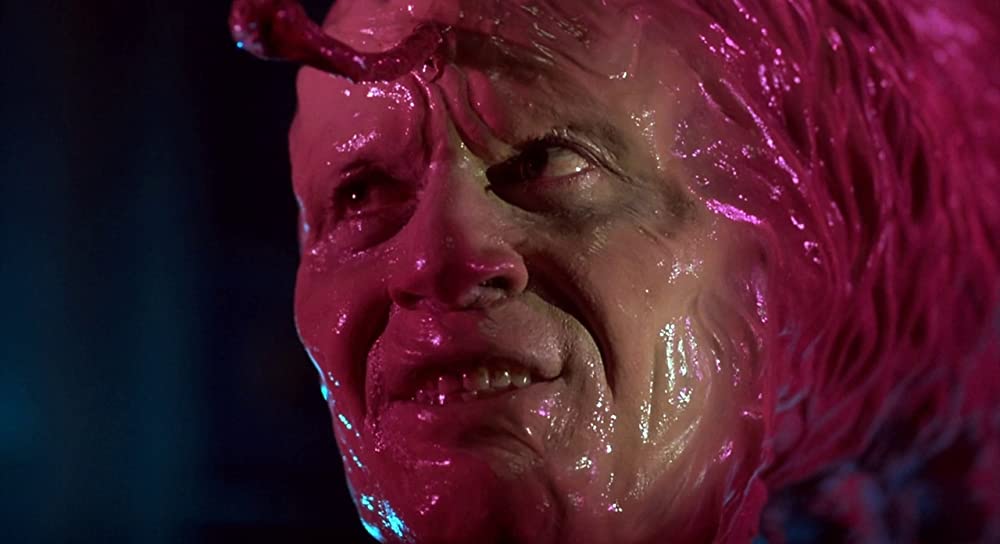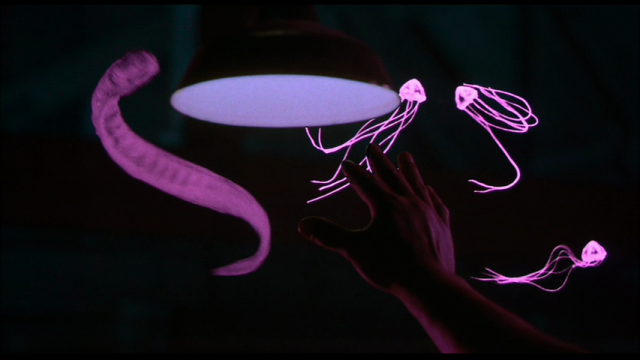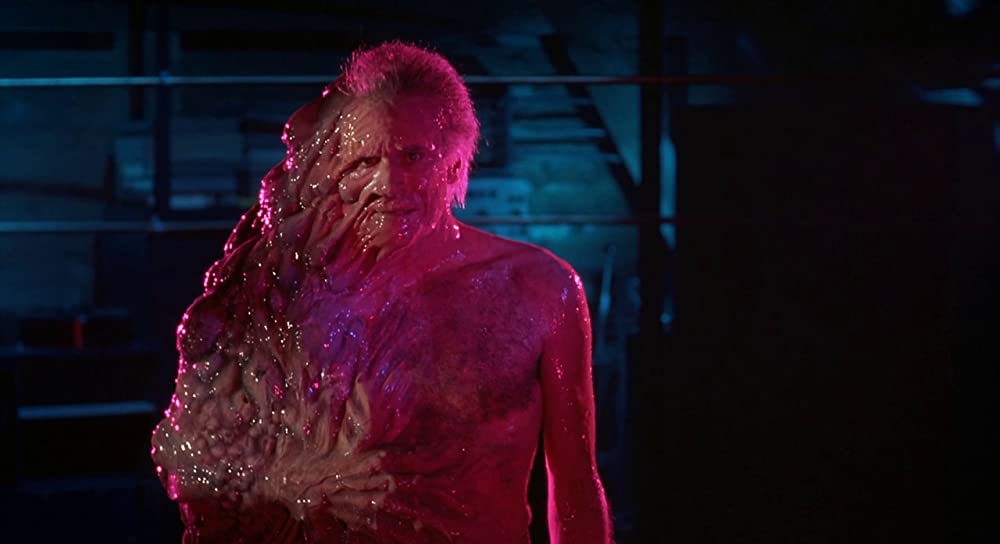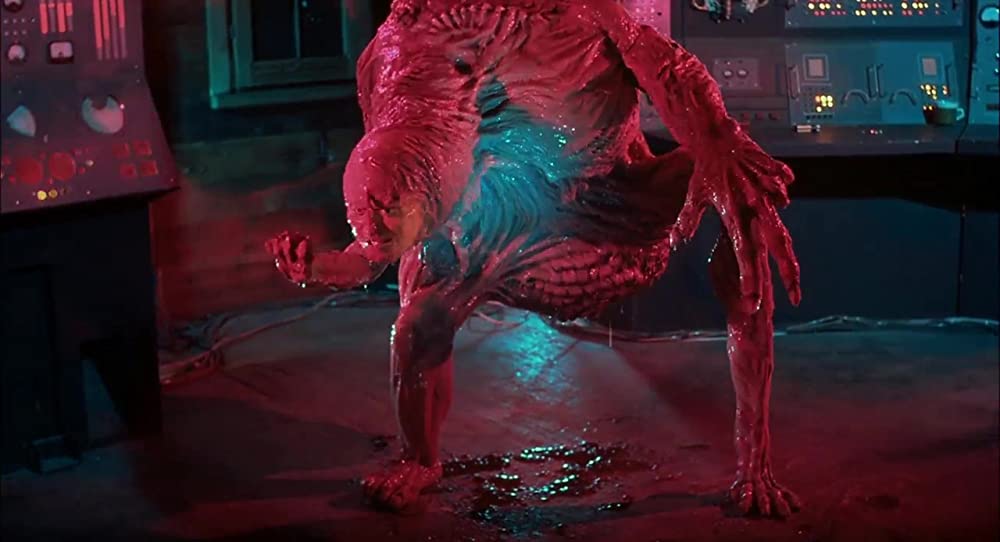
With the cult success of their film Re-Animator, director Stuart Gordon and producer Brian Yuzna (alongside co-writer Dennis Paoli) cemented their status as the top cinematic translators of HP Lovecraft’s influential horror stories—which was really not that hard to do, considering that there was only a handful of Lovecraft-based films before them (such as Die, Monster, Die!), and none of them were particularly notable. Maybe the atmosphere of boundary-pushing and the increasing sophistication of special effects found in eighties horror films is what made adapting Lovecraft’s existential abominations seem more attainable, and the Gordon/Yuzna line of movies do capture the sense of strangeness and dread that defined those stories that the ones made in the shadow of Hammer-style Gothic horror did not. At the same time, the other things that define Stuart and Yuzna’s movies are a comedy streak and a perverted parody of sexuality that are very much not found within the more repressed words of Lovecraft’s pulp fiction—they get the spirit of the thing, but bring plenty of their own spirit as well.
The team’s immediate follow-up to Re-Animator, once again distributed by Charles Band’s Empire Pictures (it’s funny to consider that Gordon’s style of film, while vastly superior, is not entirely dissimilar from Band’s usual effects-based schlock, stuff like Ghoulies and the roughly 400,000 Puppet Master and Evil Bong movies) and starring Jeffrey Combs and Barbara Crampton, adapted a lesser-known early story by Lovecraft, one whose simple story proved rife with possibility. From Beyond leans less in the overt comedy direction of it predecessor—although it certainly indulges in some ridiculousness, which is always part of the appeal of these movies—but goes more towards the mind-bending otherworldly implications. Just beneath the surface of our rational reality are inexplicable things, and if we were to get a glimpse of what is lurking just outside our senses, then sanity goes right out the window—that’s the recurring theme of Lovecraftian fiction, and this movie uses it as a vehicle not just for very eighties gory and gooey practical effects, but to really get into some of its creators’ other pet themes as well, producing a rather joyously disgusting deep dive into madness.

Jeffrey Combs plays Dr. Crawford Tillinghast, who was the crucial mad scientist in the original story, but here is the assistant to the far more mad scientist Edward Pretorius (played by Ted Sorel), named after the daffy mentor to Dr. Frankenstein in Bride of Frankenstein—the two of them have crafted a device called the Resonator, a classic piece of wacky sci-fi tech that allows those within its vicinity to see things on other frequencies of existence. Them turning the thing on is the pre-credits sequence of the movie, getting us right into the thick of things—and we learn in the thick of things that, all this time, we’ve been surrounded by translucent sea life swimming in the air. But while the Resonator allows us to see those weird critters, it also allows them to see us, and Tillinghast is attacked by a particularly vicious little eel-beast, our first of many puppets, before he turns the machine off. Despite Tillinghast’s urging for caution, Pretorius is fully ready to turn the thing back on and soak it in, and seems to get a real thrill from the breaking down of reality (we don’t know the half of it just yet!) This eventually leads to Pretorius with his head twisted off and Tillinghast running screaming out of the house with an axe—then we get to see the credits.

Stuck in a mental health facility rambling about the things he saw happen (his only explanation to authorities about what happened to Pretorius: “It bit his head off…like a gingerbread man…”), Tillinghast’s case is taken on by Crampton as hotshot psychiatrist Dr. Katherine McMichaels, who wants to take him back to the house and see the Resonator working for herself, despite his protests. The medical authorities and the police allow her to go back to Pretorius’ classically spooky house (portrayed in long shots by a particularly well-integrated miniature) with Tillinghast and officer Bubba Brownlee, played by Dawn of the Dead‘s Ken Foree, and things go a bit topsy-turvy from there. Throughout the early parts of the movie, Katherine comes off as someone willing to forego scruples in the name of her idea of scientific advancement, not unlike Pretorius, even if she tries to explain it as some noble calling—after seeing on a CT scan that Tillinghast’s pineal gland has become enlarged, she thinks Pretorius’ experiment may help her prove that schizophrenia is connected to that part of brain and allow for new treatments. With that said, she ignores clear warnings from people who know more about the Resonator, like Tillinghast, or people with a much clearer sense of self-preservation, like Bubba, and it’s clear that curiosity and a desire for personal advancement blind her judgment—and considering the even more cold, clinical approach of her counterpart Dr. Bloch (named after Psycho author Robert Bloch, who had been the kid sidekick of Lovecraft’s writer circle), this movie doesn’t seem to have a particularly positive view of psychiatry in general.

What they find when they turn the Resonator back on—accompanied by some classic stock sound effects for sci-fi machines and strong winds (the hospital’s automatic doors even have the Star Trek door sound, so this is a truly great movie for cartoony sound effects!)—is not only more bitey translucent puppets, but Pretorius…alive and well? More than well, as it turns out: his decapitation experience has fused him with a creature of the other-dimension, transforming him into a malleable entity who loves to share his naked bod and then rip the flesh off said naked bod. As we learn, Pretorius is not just a scientist interested in other dimensions, but a BDSM deviant who was really looking for the another, grander kind of carnal pleasure (not unlike the characters from Clive Barker’s Hellraiser)—and now he’s hankering to turn into a blobby worm beast and inflict his sadism on others, especially Katherine. They are able to turn the machine off again, but Katherine ends up compelled to take another dip into the terror dimension—sometimes it seems like the effects of exposure to the other world on the pineal gland makes her do things against her will (at one point, she goes into Pretorius’ S&M room, puts on the leather get-up, and starts writhing on a near-comatose Tillinghast before she snaps out of it), but other times it just seems to be a moment of weakness, unwilling to avoid to the temptation of discovery. The cliche of the scientist lustfully seeking the forbidden is all over fiction, including Lovecraft, and it’s not really that much of a jump to make it as explicitly sexual as it is here.

The association between the brain, sex, and forces beyond our grasp is a pretty interesting use of Lovecraftian dread, too. Much of the story amounts to people interpreting behaviour physiologically, including both mental illness and the sexual pleasure/pain dichotomy (both used to create some uncomfortable scenes throughout the movie, and sometimes even combining all of them at once.) The idea that so much of our humanity, including some of the more harmful manifestations of it, is controlled by a mechanical function of the brain, something possibly beyond our control, is not that far from the idea that those things could also be controlled by malignant forces from outside our reality—in either case, something unseen beneath the surface of perception is the master of our fate.

After a number of Resonator-based thrill sequences featuring giant worm puppets (in a movie mostly about body horror, I appreciate that they still went out of their way to include as many practical effect eldritch abominations as they could in the running time—that’s what we like to see!) and the increasingly grotesque transformations of Pretorius (as well as the death of Bubba, most of his body eaten away by interdimensional insects), Tillinghast has his pineal gland expanded to such a degree that it bursts out of his forehead as a squirming phallic stalk (which Pretorius also has), and him and Katherine are taken back to the hospital, where he is to be examined and she is sent for shock therapy by a sneering Dr. Bloch. The forehead thing is one of those hilarious and disturbing images that Gordon loves, and one based entirely on classical theories about the purpose of the pineal gland (which was associated with the idea of the Third Eye, and while the gland does have some possible relations to the sex drive, it’s mostly there to regulate sleep.) The change of venue does not give us a vacation from horror grossness, as Tillinghast’s new state allows him to see things in a “beautiful” new way, which is to say infrared with rainbow colours, but also gives him a taste for brains, which he often attempts to obtain by sucking it out of people’s eye sockets. Combs is considered one of the great horror actors for a reason, and he plays Tillinghast in every phase—from terrified paranoiac to curious brain-sucker—with the exact right combination of pathos and confident goofiness. Meanwhile, Crampton is victimized plenty in this movie, but at least she possesses an actual character whose gradual change from scientific drive to completely unravelling carries us through the end of the movie; I would hope her acting strength is the reason she is also a fan favourite in the horror circles, and not solely because she has many topless scenes.

The final confrontation back at the Resonator is a frenzy of slimy effects, some of which are astounding not only in their grossness, but also in their unique strangeness—we see a morphing flesh blob essentially fighting itself. Between this movie and Yuzna’s directorial debut Society, released a few years later, there’s a real competition in the realm of inventive repulsiveness, and SFX creators John Carl Buechler (director of other Charles Band productions like Troll and Ghoulies III: Ghoulies Go To College, among many other things) and John Naulin outdo themselves in the finale even compared to the wacky stuff we saw earlier in the movie. Looking back at the contemporary reviews, From Beyond was treated much more fairly than a lot of gross-out horror films were at the time, and it’s nice to know that Gordon’s talent as a director was recognized—this is just a very well-made film, which effectively uses a small number of sets, and drenches each scene with a disquieting ambience, often with the help of hot pink lighting that emphasizes the bizarre alien quality of the story. And in keeping with the Lovecraft tradition, the movie ends with the only survivor of the events succumbing to the madness of what has unfolded—it’s the only way a movie like this could end, really.

